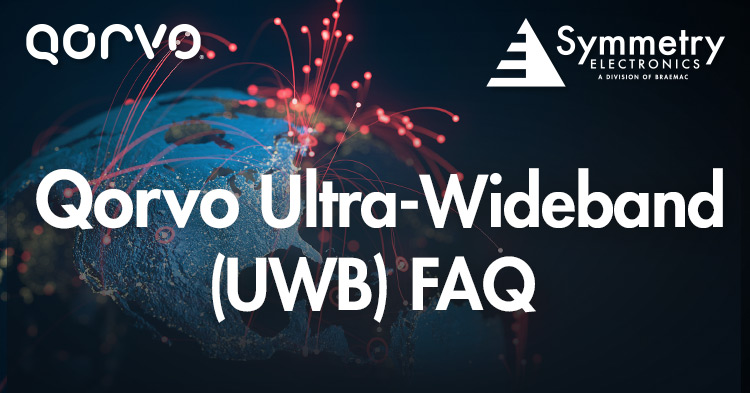- Home
- Braemac Blog
- Qorvo-Decawave Ultra-Wideband (UWB) FAQ
Qorvo Ultra-Wideband (UWB) FAQ | Symmetry Blog
About Tyler Wojciechowicz
1. Why do customers choose ultra-wideband (UWB) over other technologies?
- UWB is highly immune to multipath and interference, unlike Wi-Fi and Bluetooth
- 10 cm accuracy versus one meter or more
- 98% reliability compared to 70% ~ 80% (improving battery life)
- Supports location tracking
2. Does UWB offer the same direction-finding accuracy as Bluetooth 5.1 and 5.2?
Although Bluetooth 5.1/5.2 can achieve great accuracy with direction-finding due to Angle of Arrival (AoA), the technology operates in a narrower band than ultra-wideband, causing it to be sensitive to multipath. However, UWB can circumvent the narrowband issues associated with Bluetooth (BLE). Additionally, since Bluetooth operates at a lower frequency, most antennas and antenna arrays are larger to achieve angular accuracy for a given ‘field of view’.
3. Is there a limit on the number of UWB devices you can have in a given area?
Yes. UWB is a radio frequency (RF)–all RFs have data rate and data congestion limitations. However, depending on the data update frequency, a UWB transceiver’s transmit packet typically sends information in short bursts of a couple hundred microseconds–thus enabling a higher density of devices (a few hundred to a few thousand) to operate in a single room at a time. Additionally, thousands of UWB devices can operate seamlessly with one another in a commercial building consisting of multiple rooms.
4. How many times per second do anchors/tags send and measure distance?
The tags and anchors in Qorvo’s technologies use a Two-Way Ranging Protocol to exchange messages and calculate the range/distance between nodes. To calculate a single range, a minimum of two messages are required (if a tag needs to be told of the range result, the information can either be sent via the next response message or through an additional third message that can be communicated through a report such as a Time of Flight (ToF) report.
Qorvo’s DW1000 UWB wireless transceiver supports various data rates and preamble combinations. Depending on the preamble length and data rate used, a single message can vary between 190 µs (6.81 Mbps, 27 bytes, 128 preamble) to 3.4 ms (110 kbps, 27 bytes, 1024 preamble). This means that the time to calculate a single range can vary anywhere from less than a millisecond to tens of milliseconds.
In Time Difference of Arrival (TDoA) systems, the blink frame (with a preamble length of 64-symbols and 12 octets of message payload) is typically around 110 µs. This means that the Real Time Location System (RTLS) can support 1700 blinks per second for one device or 170 blinks per second for ten devices. For more information, see Section 9.5 - Node Density and Air Utilization from Qorvo’s DW1000 User Manual.
5. What battery life should be expected from UWB devices and what tools are available for determining the approximate power consumption of UWB devices?
Qorvo has produced useful Power Consumption Calculators to help design engineers ballpark their power consumption requirements. In general, you can expect UWB to be extremely low power due to its >=98% accuracy. Compared to other wireless technologies like BLE and Wi-Fi, UWB conserves energy much more efficiently by minimizing the amount of times it must wake up devices or re-send data packets.
6. What are the basic requirements for UWB firmware development?
Basic software can be downloaded from the Qorvo Design Hub. If additional software is required, it is generally provided by the system developer or by third-party partners. Additional guidance can also be found in a product’s designated API Guide and System User Manual or application notes.
7. What software resources are available from Qorvo?
Visit the Qorvo Design Hub for product documentation, application notes, certification and compliance, UWB antenna design files, software, whitepapers and videos.
8. Are Qorvo products interoperable with cellphones?
Yes, newer smartphones are adopting UWB as a wireless standard for precise location-based services; including secure transactions (think of Near Field Communication (NFC)), secure access, proximity monitoring (secure bubble), etc. A few examples of UWB-enabled products that are available on the market include Apple’s iPhone 11 (2019) and iPhone 12, the latest Apple watches, Samsung’s Note20 smartphone family, and several other manufacturers that have products currently in development. Additionally, UWB’s precision and accuracy has unlocked an entire new series of applications such as AR/VR tracking, air mouse, and audio ‘sweet-spot’ adjustment.
Looking to integrate Qorvo products into your design? Our Applications Engineers offer free technical design consulting. Please Contact us for more information.

